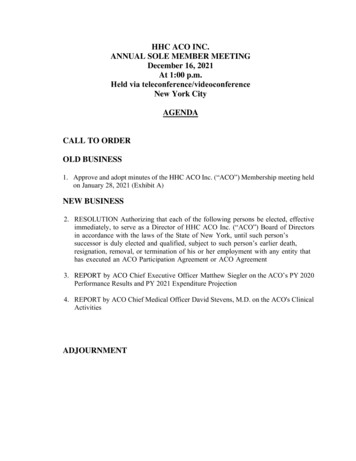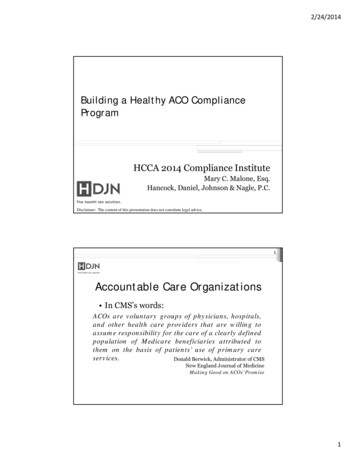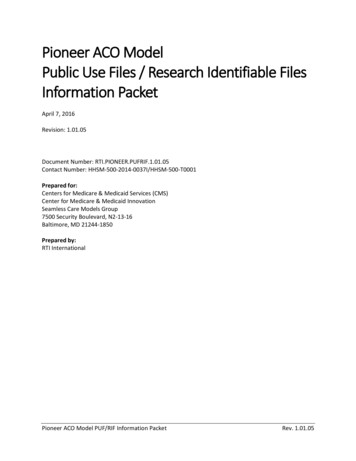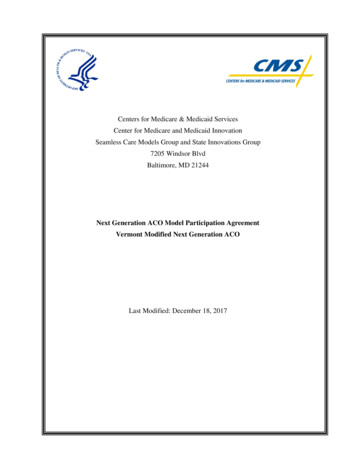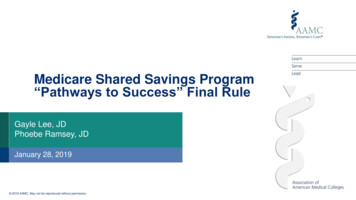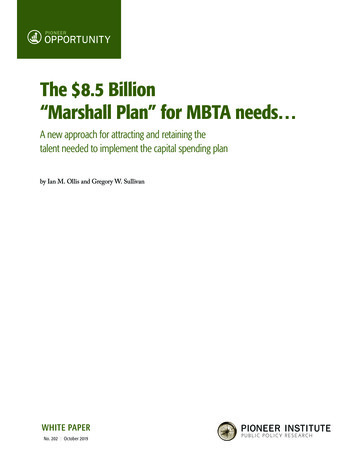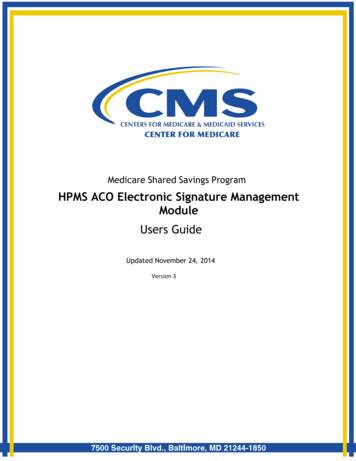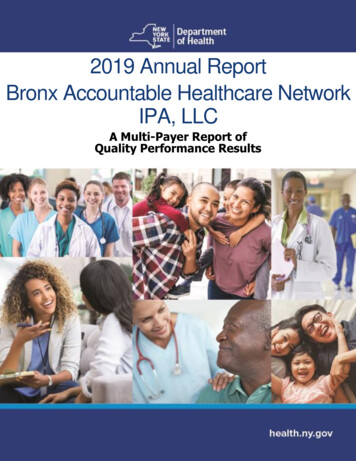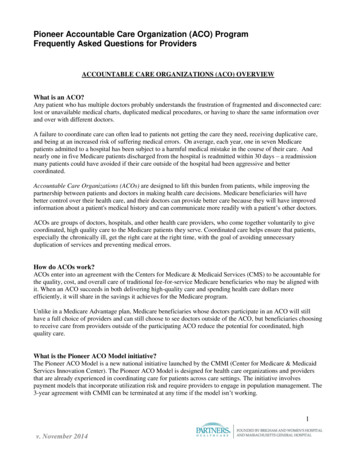
Transcription
Pioneer Accountable Care Organization (ACO) ProgramFrequently Asked Questions for ProvidersACCOUNTABLE CARE ORGANIZATIONS (ACO) OVERVIEWWhat is an ACO?Any patient who has multiple doctors probably understands the frustration of fragmented and disconnected care:lost or unavailable medical charts, duplicated medical procedures, or having to share the same information overand over with different doctors.A failure to coordinate care can often lead to patients not getting the care they need, receiving duplicative care,and being at an increased risk of suffering medical errors. On average, each year, one in seven Medicarepatients admitted to a hospital has been subject to a harmful medical mistake in the course of their care. Andnearly one in five Medicare patients discharged from the hospital is readmitted within 30 days – a readmissionmany patients could have avoided if their care outside of the hospital had been aggressive and bettercoordinated.Accountable Care Organizations (ACOs) are designed to lift this burden from patients, while improving thepartnership between patients and doctors in making health care decisions. Medicare beneficiaries will havebetter control over their health care, and their doctors can provide better care because they will have improvedinformation about a patient's medical history and can communicate more readily with a patient’s other doctors.ACOs are groups of doctors, hospitals, and other health care providers, who come together voluntarily to givecoordinated, high quality care to the Medicare patients they serve. Coordinated care helps ensure that patients,especially the chronically ill, get the right care at the right time, with the goal of avoiding unnecessaryduplication of services and preventing medical errors.How do ACOs work?ACOs enter into an agreement with the Centers for Medicare & Medicaid Services (CMS) to be accountable forthe quality, cost, and overall care of traditional fee-for-service Medicare beneficiaries who may be aligned withit. When an ACO succeeds in both delivering high-quality care and spending health care dollars moreefficiently, it will share in the savings it achieves for the Medicare program.Unlike in a Medicare Advantage plan, Medicare beneficiaries whose doctors participate in an ACO will stillhave a full choice of providers and can still choose to see doctors outside of the ACO, but beneficiaries choosingto receive care from providers outside of the participating ACO reduce the potential for coordinated, highquality care.What is the Pioneer ACO Model initiative?The Pioneer ACO Model is a new national initiative launched by the CMMI (Center for Medicare & MedicaidServices Innovation Center). The Pioneer ACO Model is designed for health care organizations and providersthat are already experienced in coordinating care for patients across care settings. The initiative involvespayment models that incorporate utilization risk and require providers to engage in population management. The3-year agreement with CMMI can be terminated at any time if the model isn’t working.1v. November 2014
How does this affect me and my practice?Participating in the Pioneer ACO should not affect how you provide care to your patients. You will continue tocare for your patients as you have done in the past.ACOs enter into an agreement with the Centers for Medicare & Medicaid Services (CMS) to be accountable forthe quality, cost, and overall care of traditional fee-for-service Medicare beneficiaries who may be aligned withit. When an ACO succeeds in both delivering high-quality care and spending health care dollars moreefficiently, it will share in the savings it achieves for the Medicare program.How does this affect billing at my practice?The Pioneer ACO is a 3-year agreement with CMS. Providers bill normally, receive standard fee-for-servicepayments in Years 1&2. If Partners meets all Pioneer ACO program requirements in Years 1&2, in Year 3 thereis an option to put a population-based payments system in place. Population-based payment is a per-beneficiaryper month payment amount intended to replace 50 percent of the ACO’s fee-for-service (FFS) payment with aprospective payment.BENEFICIARY RELATED QUESTIONSHow will beneficiaries be affected by the Pioneer ACO Model?Medicare beneficiaries will continue to receive care from their care team as they normally do. There are noincentives within the Pioneer ACO model to provide any less care than is already being given. Beneficiarybenefits are not changing under Medicare and they can continue to see the same doctors. The goal of the PioneerACO is to deliver higher quality, more seamless health care. This is accomplished by encouraging coordinationbetween health care providers, resulting in better care for beneficiaries.Who can beneficiaries contact with questions or concerns?Beneficiaries participating in the initiative may contact 1-800-MEDICARE (1-800-633-4227); TTY usersshould call 1-877-486-2048.What is beneficiary medical claims data sharing?To effectively coordinate and improve care, ACOs need complete patient medical information. Medicare claimsdata about patients' medical conditions, prescriptions, and visits to the doctor or hospital will help the ACO keepup with patients’ medical needs and track how well the ACO is doing to keep them healthy and getting the rightcare.What if a beneficiary wants to see a provider outside of the system?Unlike in a Medicare Advantage plan, Medicare beneficiaries whose doctors participate in an ACO will stillhave a full choice of providers and can still choose to see doctors outside of the ACO. Beneficiaries choosing toreceive care from providers outside of the participating ACO reduce the potential for coordinated, high qualitycare.How are beneficiaries selected for the Pioneer ACO Model?2v. November 2014
In a Pioneer ACO, beneficiaries in the ACO can be identified prospectively, allowing care providers to know inadvance which for of their patients they will be held accountable for managing the cost and quality of care.However, a beneficiary cannot opt out of being part of a Pioneer ACO, although they are permitted to opt-out ofsharing their medical claims information with the Pioneer ACO. If a patient decides not to share their CMSmedical claim data with an ACO, the ACO is still responsible for managing that patient's cost and quality ofcare.How are beneficiaries identified for the Pioneer ACO Model?CMS has identifed the Pioneer ACO’s beneficiary population through three years of fee-for-service, primarycare claims before the performance period, align those beneficiaries with the Pioneer ACO, and measure thePioneer ACO’s success or failure with that pre-identified set of beneficiaries. However, beneficiaries are free toseek care from any provider regardless of whether the provider is affiliated with the Pioneer ACO. Regardless ofwhere beneficiaries receive care, the Pioneer ACO is accountable for their total cost and outcomes.What are the Beneficiary Protections under the Pioneer ACO Model?The Pioneer ACO Model contains strong protections designed to ensure that patients will not experiencedisruptions in accessibility or quality of services. Beneficiaries can call 1-800-MEDICARE (1-800-633-4227)with questions and concerns regarding care received from the providers who are part of the ACO or for moreinformation about the initiative in general.Pioneer ACOs will also be conducting surveys of their aligned beneficiaries on an annual basis. CMS mayinvestigate the practices of ACOs that generate beneficiary complaints. CMS will publicly report theperformance of Pioneer ACOs on quality metrics, including patient experience ratings, on its website.Access to CareCMS emphasizes that payment arrangements in the Pioneer ACO should not reduce necessary care. Tosafeguard against this possibility, CMS will routinely analyze data on service utilization, and may investigateutilization patterns through comparison surveys of beneficiaries aligned with the ACO and those in the generalbeneficiary population, medical record audits, or other means. CMS will also determine whether there aresystematic differences in health status or other characteristics between patients who remain aligned with a givenACO over the life of the Pioneer ACO Model, and those who do not.What if a beneficiary would like more information on the ACO?Beneficiaries participating in the initiative may contact 1-800-MEDICARE (1-800-633-4227); TTY usersshould call 1-877-486-2048.Our website also has additional information around ACO www.partners.org/ForPatients/aco/.3v. November 2014
REIMBURSEMENT AND QUALITY MEASURESPioneer ACO Model vs. Medicare Shared Savings ProgramA section of the Affordable Care Act requires that the CMS establish a shared savings program to facilitatecoordination and cooperation among providers to improve the quality of care for Medicare beneficiaries andreduce unnecessary costs. Eligible providers and hospitals may participate in the Shared Savings Program bycreating or joining an Accountable Care Organization.How are the savings for the Pioneer ACO program calculated?The Innovation Center will develop a target per capita expenditure level (benchmark) based on a prior 3 yearaverage of actual CMS expenditures for the group of patients aligned to the Pioneer ACO. This baseline will beadjusted based on a combination of the average percentage growth rate and an absolute dollar equivalent growthrate for a national reference populationFor example, assume that the national average expenditures are 10,000 per beneficiary per year and thenational average increase is 10%. For a Pioneer ACO with average expenditures of 12,000 per beneficiary peryear, the benchmark would include 50% of the national absolute dollar increase of 1,000 ( 10,000 * .10) and50% of the percentage increase of 1,200 ( 12,000 * .10). The increase in the ACO’s expected expenditures perbeneficiary would be 1,100 ( 500 600) and its benchmark would be 13,100 ( 12,000 1,100).At the end of each performance period, participating ACOs would be judged against this benchmark, andrewarded with a portion of the savings or held accountable for increased expenditures. The actual expenditureswould have to be outside of a threshold of at least 1 percent to trigger savings or obligations. Once this 1 percenttrigger is met, it is first dollar sharing of savings and losses.How do ACOs reduce expenditures?ACOs can reduce expenditures through systematic efforts to improve quality and reduce costs across theorganization such as: Improved care coordination Chronic disease management Health risk assessments Informed patient choices Health Information Technology Point of care reminders Physician access to timely data Post acute care management Appropriate medical managementWhat are the Quality Measures?The Pioneer ACO Model will be utilizing the same quality measures and assessments defined in the final rulefor the Shared Savings Program. The rule proposes quality measures in five domains that affect patient care: Patient/caregiver experience of careCare coordinationPatient safetyPreventive healthAt-risk population/frail elderly health4v. November 2014
Where can I get additional information?For further information please visit:oACO Overview Information: http://www.cms.gov/ACO/ -Model/Results from first and second performance years: s/Pioneer-ACO-Year-1-Results.aspx s/Pioneer-ACO-Results-Year-2.aspx eer-aco/ EWS/310089921&utm source AltURL&utm medium email&utm campaign am&AllowView VXQ0UnpwZTRDdlNXL1IzSkUvSHRlRUtwajBRZEErUmM ?mh a.html LPage 1&DLSort 0&DLSortDir descending5v. November 2014
The Pioneer ACO Model is a new national initiative launched by the CMMI (Center for Medicare & Medicaid Services Innovation Center). The Pioneer ACO Model is designed for health care organizations and providers that are already experienced in coordinating care for patients across care settings. The initiative involves
